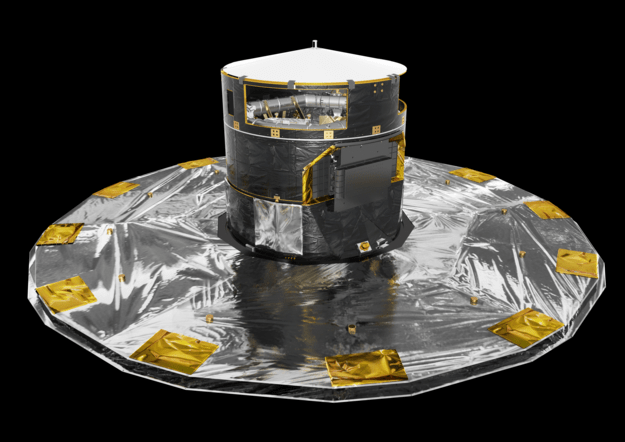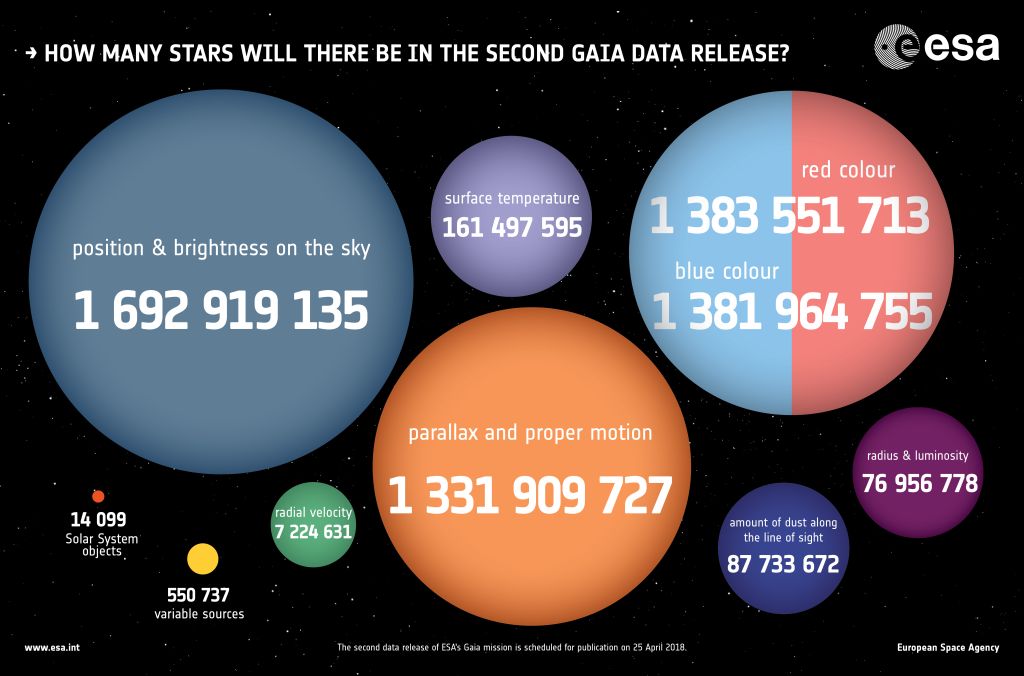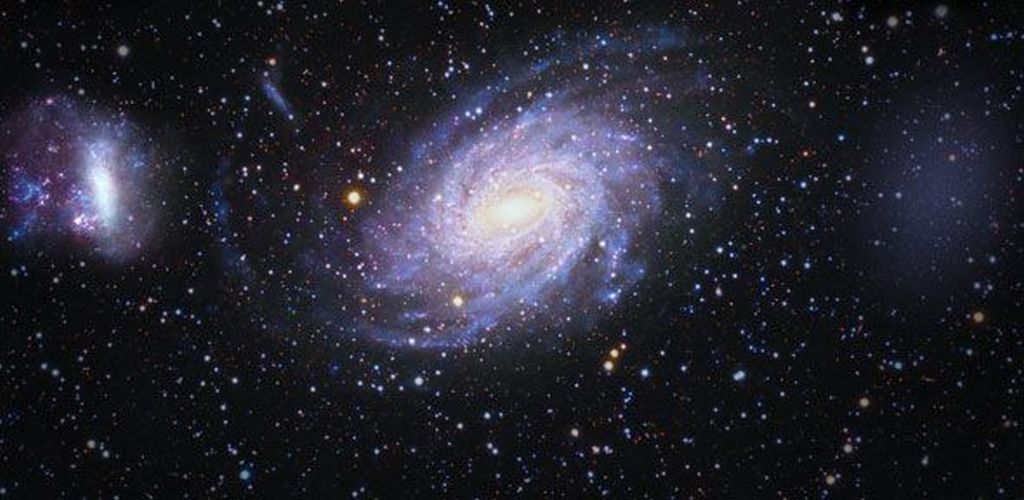Astronomers combing through data from the ESA’s Gaia spacecraft have discovered what they’re calling a ghost galaxy. The galaxy, named Antlia 2 (Ant 2) is an extremely low-density dwarf galaxy that was formed in the early days of the universe. And it is being stripped of its mass by the tidal forces of the Milky Way.
This ghost galaxy has been hiding in plain sight all along. It’s low density made it hard to detect, and so did its location. It’s hidden behind the shroud of the Milky Way’s disc, in an area known to astronomers as the “Zone of Avoidance” (ZOA.) But it’s enormous: it’s the same size as the Large Magellanic Cloud and one third the size of the Milky Way.
An international team of astronomers found Ant 2 while going through the second data release from the Gaia spacecraft. They were looking for dwarf galaxies near the Milky Way by searching for RR Lyrae stars. RR Lyrae are variable stars used as standard candles. They’re old, metal-poor stars usually found in dwarf galaxies, so if you find RR Lyrae stars, you’ve probably found a dwarf galaxy.
In some respects, Ant 2 is like other dwarf galaxies. All galaxies, including dwarf galaxies like this one, are formed in association with dark matter. As their name makes clear, dwarfs are smaller and have fewer stars than other galaxies. A dwarf galaxy might have only a hundred million stars, maybe as many as a few billion. They’re dwarfed by our own Milky Way galaxy, which has between 200 and 400 billion stars.
“This is a ghost of a galaxy. Objects as diffuse as Ant 2 have simply not been seen before.” – Gabriel Torrealba, lead author.
The stars in a dwarf galaxy are different than the stars in other galaxies, too. Dwarf galaxies were some of the first structures to form in the universe, so their stars are older and metal-poor. They were formed in the early days, before successive generations of stars had seeded the universe with metals.
Many dwarf galaxies are subject to the gravitational tides of the larger galaxies near them, and Ant 2 is no exception. They’re often seen being pulled towards larger galaxies and being ripped apart by these interactions. This can result in galaxy mergers, and that’s what might be happening with Ant 2.
But the ghost galaxy Ant 2 differs from other dwarfs. It gives out very little light. Compared to another of the Milky Way’s satellite galaxies, the Large Magellanic Cloud, it is 10,000 times fainter. Depending on how you look at it, it’s either too large for its luminosity, or too dim for its size.
“This is a ghost of a galaxy,” said Gabriel Torrealba, the paper’s lead author. “Objects as diffuse as Ant 2 have simply not been seen before. Our discovery was only possible thanks to the quality of the Gaia data.”

The ESA’s Gaia mission has produced the richest star catalogue to date, including high-precision measurements of nearly 1.7 billion stars. It has revealed previously unseen details of our home Galaxy, and shown how the Milky Way formed by merging with another galaxy 10 billion years ago. Earlier this year, Gaia’s second data release made new details of stars in the Milky Way available to scientists worldwide, and it’s been a treasure trove for astronomers, including the team behind the ghost galaxy.

The team of astronomers behind the study hail from Taiwan, the UK, the US, Australia and Germany. They were searching Gaia’s second data release for RR Lyrae stars, hoping to find more dwarf galaxies. These old stars have well-understood pulses of brightness that last a half a day, so they’re very useful.
“RR Lyrae had been found in every known dwarf satellite, so when we found a group of them sitting above the Galactic disc, we weren’t totally surprised,” said co-author Vasily Belokurov from Cambridge’s Institute of Astronomy. “But when we looked closer at their location on the sky it turned out we found something new, as no previously identified object came up in any of the databases we searched through.”
“We are wondering whether this galaxy is just the tip of an iceberg, and the Milky Way is surrounded by a large population of nearly invisible dwarfs similar to this one.” – co-author Matthew Walker, Carnegie Mellon University.
The team notified their colleagues at the Anglo-Australian Telescope (AAT) in Australia. Under a tight timeline, astronomers at the AAT measured the spectra of more than 100 red giant stars in the ghost galaxy. Those spectra provided the confirmation the team needed.
The spectra showed that all the stars were moving together. Ant 2 never comes too close to the Milky Way, always staying at least 130,000 light-years away. The researchers were also able to obtain the galaxy’s mass, which was much lower than expected for an object of its size.
The Simplest Explanation for this Ghost Galaxy… Maybe
“The simplest explanation of why Ant 2 appears to have so little mass today is that it is being taken apart by the Galactic tides of the Milky Way,” said co-author Sergey Koposov from Carnegie Mellon University. “What remains unexplained, however, is the object’s giant size. Normally, as galaxies lose mass to the Milky Way’s tides, they shrink, not grow.
So Ant 2 is a bit of a mystery for astronomers. It’s very large for something with such a low mass. Removing mass can’t make the ghost galaxy larger; that makes no sense. There must be another reason it’s growing in size while losing mass, but so far nobody knows. Our current theories of galaxy formation don’t predict objects like Ant 2.
One line of speculation suggests that very vigorous star formation inside Ant 2 could cause it to expand while the Milky Way steals its mass. Stellar winds and supernova explosions could push away the unused gas, weakening the gravity that binds the galaxy and allowing the dark matter that it’s associated with to expand. But this isn’t proven.
“Even if star formation could re-shape the dark matter distribution in Ant 2 as it was put together, it must have acted with unprecedented efficiency,” said co-author Jason Sanders, also from Cambridge.
Another line of speculation involves dark matter itself, maybe another type of dark matter. Current theory predicts that dark matter packs tightly in the center of galaxies. But the diffuse, spread out nature of Ant 2 might mean that a type of dark matter that doesn’t cluster as easily is at work. As the team says in their paper, “The origin of this core may be consistent with aggressive feedback, or may even require alternatives to cold dark matter (such as ultra-light bosons).”
“Compared to the rest of the 60 or so Milky Way satellites, Ant 2 is an oddball,” said co-author Matthew Walker, also from Carnegie Mellon University. “We are wondering whether this galaxy is just the tip of an iceberg, and the Milky Way is surrounded by a large population of nearly invisible dwarfs similar to this one.”
Finding an oddball ghost galaxy like Ant 2 is perplexing, but it wasn’t entirely unexpected. As detection methods have become more sensitive, more dim satellite galaxies have been found. It was probably only a matter of time until one was found here, in the ZOA. But whether it’s the only one we ever find, or whether we’ve stumbled onto the first of many thanks to the power of the Gaia spacecraft is still an open question. Either way, it’s making astronomers re-think their most workable theories.
Sources:
- Cambridge University Press Release: “Gaia spots a ‘ghost’ galaxy next door”
- Research Paper: “The hidden giant: discovery of an enormous Galactic dwarf satellite in Gaia DR2”
- ESA Gaia page
- Wikipedia: RR Lyrae Stars

